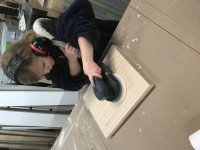ear3
Member
A good friend of mine, who recently adopted the foster son who had been in her care for a couple of years, is making the decision to pull him out of school and begin home-schooling. It's obviously a big decision, but one that she's taken time and careful consideration to arrive at. He's an incredibly sharp kid, but due to the difficult living circumstances of the first couple of years, where he was at times living in abandoned buildings, he's got some extra behavioral/emotional stuff that make the rigid structures of the typical classroom a challenge, particularly when the teachers are not willing or able to give him the space and patience he needs to keep up (in fairness to the teachers, there is understandably sometimes only so much they can do when they have a classroom of other demanding kids to attend to).
My friend has asked me to consider in the future developing a woodworking component for his home-school curriculum, both as an end in itself and as a vehicle for learning math and computational skills. He is 7 years old, so right at the age when he could start to learn some basics of hand tooling, but obviously only in a heavily supervised/guided fashion.
Just wondering if anyone out there has experience with this -- not necessarily home-schooling, but teaching woodworking to kids in a more structured way. There seem to be a lot of resources online, but I want to try to be focused about my research and not simply grab the first few things that pop up. Unfortunately, by the time I went through elementary and high school, shop class had already passed out of the curriculum, and so I don't have any direct experience to draw upon from when I was taught as a kid.
My friend has asked me to consider in the future developing a woodworking component for his home-school curriculum, both as an end in itself and as a vehicle for learning math and computational skills. He is 7 years old, so right at the age when he could start to learn some basics of hand tooling, but obviously only in a heavily supervised/guided fashion.
Just wondering if anyone out there has experience with this -- not necessarily home-schooling, but teaching woodworking to kids in a more structured way. There seem to be a lot of resources online, but I want to try to be focused about my research and not simply grab the first few things that pop up. Unfortunately, by the time I went through elementary and high school, shop class had already passed out of the curriculum, and so I don't have any direct experience to draw upon from when I was taught as a kid.


